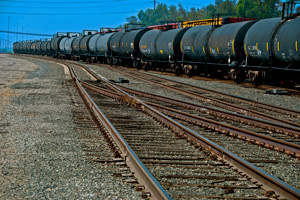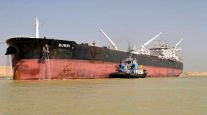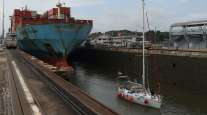Railroads Caught by Speed of Crude-Oil Collapse

The slowdown that North American railroad companies had been bracing for in crude oil shipments has turned into a rout, with volumes falling faster than executives had predicted.
With energy companies scaling back drilling after prices for the commodity fell about 50% since July, industry executives and analysts anticipated that demand for hauling crude and extraction materials such as frac sand and pipes would slow after a four-year surge. They didn’t expect it to slow this much this fast.
“The impact is occurring more quickly than the rails originally projected to investors,” said Matt Troy, an analyst with Nomura Securities International Inc. in New York. “The consensus view was that very high double-digit growth would moderate to low double digits, and as we have seen in recent weeks we’ve broken that floor and in some cases gone negative.”
Rail stocks are reflecting the slowdown in traffic. The Standard & Poor’s 500 Railroads Index is on course for the biggest weekly decline since September 2012.
As recently as January, companies including CSX Corp. and Canadian Pacific Railway Ltd., were forecasting that even with prices below $50 a barrel, oil projects already under way would buoy production and keep trains hauling even more crude than last year. Instead carloads of U.S. petroleum products fell 2.8% in the last four weeks after growing 13% last year.
Beau Maida, director of rail services at GT OmniPort, sees the effects first hand from a freight yard on Texas’ Gulf Coast.
“I’m definitely seeing the drop-off,” Maida said in an interview. GT OmniPort is situated near two refineries at Port Arthur, Texas, and has 8.5 miles of track and facilities to offload crude from railcars.
The weakness contrasts with the industry’s struggle to keep pace with demand to haul crude as drilling reached areas that traditionally weren’t connected by pipelines. Carloads of crude jumped to 493,000 last year from 11,000 in 2009 as new extraction techniques known as hydraulic fracturing helped push U.S. crude production to its highest in at least three decades.
“This is the first time that anybody has slowed down on fracking,” said Taylor Robinson, president of Chicago-based PLG Consulting, which advises rail companies. “Nobody knew how fast they could shut down and it looks like they’re pretty fast.”
Some railroads are adjusting to the new reality. CSX no longer expects to reach the high end of its forecast for crude carloads this year, though it still estimates they’ll increase, Melanie Cost, a spokeswoman, said in an e-mail March 26.
CSX Chief Executive Officer Michael Ward said in a Jan. 14 interview that crude trains may rise to an average of 4 to 4.5 a day, an increase of as much as 29%. In the last four weeks, CSX’s petroleum products carloads rose 3.6% following a 60% gain last year, according to Association of American Railroads statistics.
Kansas City Southern earlier this week reduced its 2015 revenue growth forecast in part because of lower-than-expected crude-by-rail shipments and a 20% decline in coal revenue in the first quarter as utilities switch to cheaper natural gas.
The company now forecasts a revenue increase in the low single digits, down from an earlier prediction of mid-single-digit growth.
“That’s a little bit of an indicator of things to come,” Keith Schoonmaker, an analyst with Morningstar Inc., said in a phone interview.
Others are sticking to their projections for now.
Martin Cej, a spokesman for Canadian Pacific, said in an e-mail his railroad hasn’t changed its forecast of 140,000 crude carloads in 2015. Canadian Pacific posted a 9.1% increase in petroleum product carloads in the last four weeks. That’s down from 16% last year and a third of the railroad’s forecast for a 27% gain in crude only carloads this year.
BNSF Railway Co., the railroad owned by Warren Buffett’s Berkshire Hathaway Inc., posted a 4.5% drop in petroleum products in the last four weeks after a gain of 12.4% last year. BNSF’s network runs through North Dakota, making it the largest hauler of Bakken oil production. Union Pacific Corp., which serves Texas oil fields, saw its carloads plummet 25% in the four-week period.
Demand for Bakken crude from U.S. East Coast refineries may decline as the price premium for imported Brent crude narrows. It costs about $2 to $3 a barrel to ship Brent by boat while hauling Bakken crude by train adds as much as $14 a barrel, PLG’s Robinson said. About 70% of Bakken crude now goes to East Coast refineries, he said.
“My suspicion is that the East Coast is going to get hit with more imports,” Robinson said.
Demand for frac sand, used to prop open the cracks in shale stone to release trapped oil, can be an early indicator of activity linked to the oil industry. Many wells are being drilled just to meet contractual obligations without taking the final step to frack them to produce oil. Fracking entails pumping water and chemicals into a well at high pressure to break up the shale rock to allow oil to escape.
“Frac sand is going to fall off very quickly,” Robinson said. “Oil production within a couple of months is going to fall off very quickly.”
Union Pacific’s carloads of stone, sand and gravel, which includes frac sand, fell 6.3% in the last four weeks after jumping 22% last year. BNSF saw those types of carloads drop 3% after increasing 18% last year.
The outsized growth of crude trains had pumped up rail profits even though oil accounts for only about 2% to 3% of carload volume. That percentage often doubles when factoring in the frac sand, pipe and other materials needed for drilling, Nomura’s Troy said. Union Pacific has said its total exposure to oil is 4.5% of volume while Canadian Pacific’s is about 10%.
“The energy complex which was a friend to the railroads over the last two years is rapidly becoming a foe with respect to sentiment,” Troy said.




